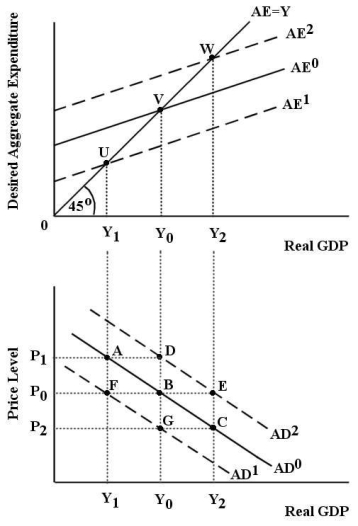Multiple Choice
 FIGURE 23-1
FIGURE 23-1
-Refer to Figure 23-1.Assume the economy is initially in equilibrium with desired aggregate expenditure equal to real GDP at point V.The price level is  .Other things being equal,exogenous changes in the price level will cause
.Other things being equal,exogenous changes in the price level will cause
A) movement along the aggregate expenditure curve  and shifts of the AD curve.
and shifts of the AD curve.
B) movement along the aggregate expenditure curve  and movement along the aggregate demand curve
and movement along the aggregate demand curve  .
.
C) shifts of the AE curve and shifts of the AD curve.
D) shifts of the AE curve and movement along the aggregate demand curve  .
.
E) no change in either the AE curve or the AD curve.
Correct Answer:

Verified
Correct Answer:
Verified
Q5: Consider the AD/AS model.Suppose there is a
Q29: Other things being equal,an exogenous rise in
Q30: Consider the relationship between the AE curve
Q33: <img src="https://d2lvgg3v3hfg70.cloudfront.net/TB5441/.jpg" alt=" FIGURE 23-5 -Refer
Q34: All points on an economy's AD curve<br>A)correspond
Q36: Consider the nature of macroeconomic equilibrium.If,at a
Q37: <img src="https://d2lvgg3v3hfg70.cloudfront.net/TB5441/.jpg" alt=" FIGURE 23-5 -Refer
Q54: Consider two economies,A and B.Economy A has
Q71: Consider the basic AD/AS model.If their unit
Q132: Consider the following news headline: "Threat of